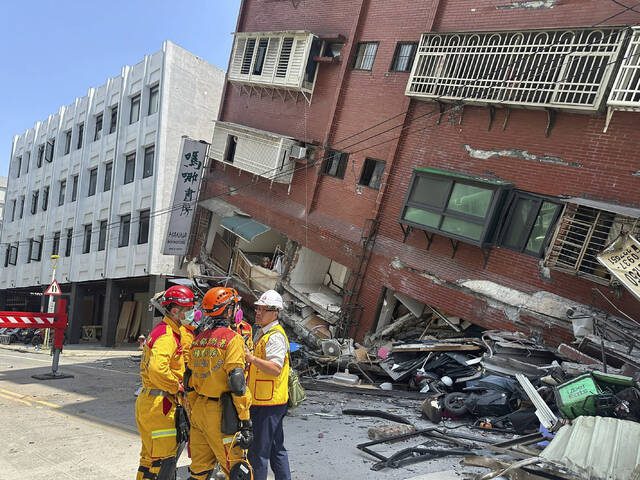HUALIEN, Taiwan — The most powerful earthquake in 25 years struck Taiwan on Wednesday morning, killing nine people, trapping many workers at quarries, and forcing some residents to escape through damaged buildings.
The earthquake, which also caused over 1,000 injuries, was centered off the coast of rural, mountainous Hualien County. Some buildings in the area were severely tilted, with their lower floors crushed. Around 150 kilometers (93 miles) away in Taipei, tiles fell from older buildings, and schools moved students to sports fields due to aftershocks.
Rescuers spread out in Hualien, searching for trapped individuals and using excavators to stabilize damaged structures. The number of people missing, trapped, or stranded varied as authorities discovered more people in distress and worked to locate or free them.
Approximately 70 workers trapped at two rock quarries were safe, according to Taiwan’s national fire agency, but the roads leading to them were damaged by falling rocks. Six workers were scheduled to be airlifted on Thursday.
In the immediate hours following the earthquake, neighbors and rescue workers were visible on TV lifting residents, including a toddler, through windows and onto the street, after doors became stuck during the shaking.
Taiwan frequently experiences earthquakes, and its population is well-prepared for such events. However, authorities were anticipating a relatively mild earthquake and did not issue alerts. The eventual earthquake was strong enough to frighten even those accustomed to such tremors.
“I’ve grown used to (earthquakes). But today was the first time I was scared to tears by an earthquake,” said Hsien-hsuen Keng, a resident who lives in a fifth-floor apartment in Taipei. ”I was awakened by the earthquake. I had never felt such intense shaking before.”
At least nine individuals perished in the quake, which occurred just before 8 a.m., according to the fire agency. The local United Daily News reported that three hikers perished in rockslides in Taroko National Park, located in Hualien, and that a van driver died in the same area when boulders struck the vehicle.
A tsunami warning was activated but later lifted.
Over 1,011 people were reported to have sustained injuries. Initially, authorities lost contact with 50 hotel employees in minibuses in the national park after the quake disrupted phone networks; three employees made their way to the hotel, while the rest remained stranded.
The quake and its aftershocks triggered 24 landslides and caused damage to roads, bridges, and tunnels. The national legislature, a former school constructed prior to World War II, and parts of the main airport in Taoyuan, just south of Taipei, also sustained minor damage.
Hualien Mayor Hsu Chen-wei stated that 48 residential buildings in the city, which shares its name with the county, were damaged. Hsu mentioned that efforts were underway to restore water and electricity supplies.
Taiwan’s earthquake monitoring agency reported the quake as 7.2 magnitude, while the U.S. Geological Survey measured it at 7.4. The epicenter was approximately 18 kilometers (11 miles) off Hualien on Taiwan’s east coast, and the quake occurred at a depth of about 35 kilometers (21 miles). Several aftershocks ensued.
Traffic on the east coast came to a virtual standstill after the earthquake, with landslides and falling debris hitting tunnels and highways. Train service was suspended across the island of 23 million people, with some tracks bent by the stress of the quake, as was subway service in Taipei, where parts of a newly built elevated line separated but did not collapse.
The initial fear after the earthquake quickly faded on the island, which prepares for such events with drills at schools and notices issued via public media and mobile phone. Stephen Gao, a seismologist and professor at Missouri University of Science and Technology, said Taiwan's readiness is among the most advanced in the world and includes strict building codes and a world-class seismological network.
By noon, the metro station in the busy northern Taipei suburb of Beitou was once again busy with people commuting to jobs and people arriving to visit the hot springs or travel the mountain paths at the base of an extinct volcano.
The earthquake was felt in Shanghai and several provinces along China's southeastern coast, according to Chinese media. China and Taiwan are about 160 kilometers (100 miles) apart.
The Japan Meteorological Agency reported a tsunami of 30 centimeters (about 1 foot) was detected on the coast of Yonaguni island about 15 minutes after the quake struck. Smaller waves were measured in Ishigaki and Miyako islands. All alerts in the region had been lifted by Wednesday afternoon.
Taiwan is located along the Pacific "Ring of Fire," the line of seismic faults encircling the Pacific Ocean where most of the world's earthquakes occur.
Hualien was last hit by a deadly quake in 2018 that killed 17 people and brought down a historic hotel. Taiwan's worst quake in recent years occurred on Sept. 21, 1999, with a magnitude of 7.7, causing 2,400 deaths, injuring around 100,000 and destroying thousands of buildings.
The economic impact of the quake has yet to be calculated. Taiwan is the leading manufacturer of the world's most advanced computer chips and other high-technology items that are highly sensitive to seismic events. Parts of the electricity grid were shut down, potentially causing disruptions in the supply chain and financial losses.
Taiwanese chipmaker TSMC, which provides semiconductors to companies such as Apple, said it evacuated employees from some of its factories in Hsinchu, southwest of Taipei. Hsinchu authorities said water and electricity supplies for all the factories in the city's science park were functioning as normal.
The Taiwan stock exchange opened as usual on Wednesday, with the index fluctuating between losses and gains.



